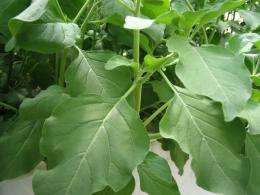New Anti-Cancer Compound Derived from Ancient Plant

(PhysOrg.com) -- University of Arizona scientists have used a new quick-growing technique to produce a water-soluble form of a plant compound that combats cancer and encourages the survival of healthy cells.
Research trials are under way on this sulfate form of withaferin A, which could develop into a new anti-cancer drug.
Scientifically studied since the 1960s, withaferin A reduces tumor mass by preventing the growth of blood vessels that make a tumor malignant. The compound is derived from the roots of a winter cherry plant, the extracts of which have been used for more than 3,000 years in India as a general tonic to build stamina, improve mental concentration, relieve stress and enhance health.
"Finding a water-soluble analog of withaferin A is significant, especially if it turns out to be a clinically useful drug," said Leslie Gunatilaka, director of the UA's Southwest Center for Natural Products Research and Commercialization, or Natural Products Center.
Withania is widely cultivated for commercial use in its native India, and also in the Middle East and in North America. It often is sold under the name ashwagandha as a dietary supplement in the U.S. and Europe.
Although traditionally grown outdoors in soil, the UA team decided to use an entirely nontraditional method - aeroponics - to produce bulk amounts of withaferin A needed for biological evaluation.
In aeroponics, plants are set over enclosed chambers where their suspended roots are misted with water and nutrients, instead of growing in soil.
The withania plants grew about five times larger using this method than if they had been grown in soil.
"Using the aeroponic system for cultivation, we were able to produce more than 20 grams of withaferin A in a single greenhouse. It normally costs around $195 for just 10 milligrams," Gunatilaka said. "Also, it usually takes two to three years to mature to sizeable roots to be commercially viable, but here it takes just six to nine months."
Not only did the aeroponic method yield bigger plants faster, with more withaferin A than usual, it also unexpectedly stimulated the plants to produce large amounts of the new natural product - a water-soluble sulfate form of withaferin A.
Upon testing, this new form demonstrated the same bioactivity as withaferin A. It was able to inhibit the proliferation and survival of tumor cells, disrupt tumor formation and induce the healthy cells' heat-shock response to reduce stress and increase survival, according to the researchers.
The difference is that the sulfate form of withaferin A is slower acting and water-soluble; it can be converted to withaferin A in cell culture media. The researchers, expecting that this withaferin A form will convert to its active form when metabolized in the body, are pursuing further testing in animal models. The patent will be held by the UA and the Massachusetts Institute of Technology.
Natural Products Center scientists collaborated with researchers from the Whitehead Institute at MIT on this project. In addition to Gunatilaka, the researchers included Ya-ming Xu, Marilyn T. Marron, Emily Seddon and Stephen P. McLaughlin of the Natural Products Center; Dennis Ray of the UA School of Plant Sciences; and Luke Whitesell of the Whitehead Institute.
The UA College of Agriculture and Life Sciences provided funding for the project, along with the USDA.
Withaferin A is just one of hundreds of such compounds that scientists with the Natural Products Center have isolated, characterized and evaluated since the center's inception in 1996. Center researchers look for compounds in desert plants and their associated microorganisms that can improve human health and be developed as potential industrial products in Arizona.
Natural Products Center scientists have discovered several other compounds in desert organisms that can significantly inhibit the growth of tumors. Many have been patented and have progressed to extended evaluation for their pharmaceutical value.
Provided by University of Arizona
















